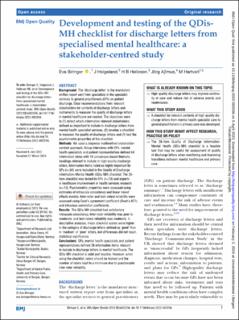| dc.contributor.author | Biringer, Eva Aaker | |
| dc.contributor.author | Helgeland, J. | |
| dc.contributor.author | Hellesen, H.B. | |
| dc.contributor.author | Assmus, Jörg | |
| dc.contributor.author | Hartveit, Miriam | |
| dc.date.accessioned | 2024-04-03T12:57:36Z | |
| dc.date.available | 2024-04-03T12:57:36Z | |
| dc.date.created | 2023-06-28T08:45:56Z | |
| dc.date.issued | 2023 | |
| dc.identifier.issn | 2399-6641 | |
| dc.identifier.uri | https://hdl.handle.net/11250/3124692 | |
| dc.description.abstract | Background The ‘discharge letter’ is the mandatory written report sent from specialists in the specialist services to general practitioners (GPs) on patient discharge. Clear recommendations from relevant stakeholders for contents of discharge letters and instruments to measure the quality of discharge letters in mental healthcare are needed. The objectives were to (1) detect which information relevant stakeholders defined as important to include in discharge letters from mental health specialist services, (2) develop a checklist to measure the quality of discharge letters and (3) test the psychometric properties of the checklist.
Methods We used a stepwise multimethod stakeholder-centred approach. Group interviews with GPs, mental health specialists and patient representatives defined 68 information items with 10 consensus-based thematic headings relevant to include in high-quality discharge letters. Information items rated as highly important by GPs (n=50) were included in the Quality of Discharge information-Mental Health (QDis-MH) checklist. The 26-item checklist was tested by GPs (n=18) and experts in healthcare improvement or health services research (n=15). Psychometric properties were assessed using estimates of intrascale consistency and linear mixed effects models. Inter-rater and test–retest reliability were assessed using Gwet’s agreement coefficient (Gwet’s AC1) and intraclass correlation coefficients.
Results The QDis-MH checklist had satisfactory intrascale consistency. Inter-rater reliability was poor to moderate, and test–retest reliability was moderate. In descriptive analyses, mean checklist scores were higher in the category of discharge letters defined as ‘good’ than in ‘medium’ or ’poor’ letters, but differences did not reach statistical significance.
Conclusions GPs, mental health specialists and patient representatives defined 26 information items relevant to include in discharge letters in mental healthcare. The QDis-MH checklist is valid and feasible. However, when using the checklist, raters should be trained and the number of raters kept to a minimum due to questionable inter-rater reliability. | en_US |
| dc.language.iso | eng | en_US |
| dc.publisher | BMJ | en_US |
| dc.rights | Navngivelse-Ikkekommersiell 4.0 Internasjonal | * |
| dc.rights.uri | http://creativecommons.org/licenses/by-nc/4.0/deed.no | * |
| dc.title | Development and testing of the QDis-MH checklist for discharge letters from specialised mental healthcare: A stakeholder-centred study | en_US |
| dc.type | Journal article | en_US |
| dc.type | Peer reviewed | en_US |
| dc.description.version | publishedVersion | en_US |
| dc.rights.holder | Copyright 2023 The Author(s) | en_US |
| dc.source.articlenumber | e002036 | en_US |
| cristin.ispublished | true | |
| cristin.fulltext | original | |
| cristin.qualitycode | 1 | |
| dc.identifier.doi | 10.1136/bmjoq-2022-002036 | |
| dc.identifier.cristin | 2158886 | |
| dc.source.journal | BMJ Open Quality | en_US |
| dc.identifier.citation | BMJ Open Quality. 2023, 12 (2), e002036. | en_US |
| dc.source.volume | 12 | en_US |
| dc.source.issue | 2 | en_US |

